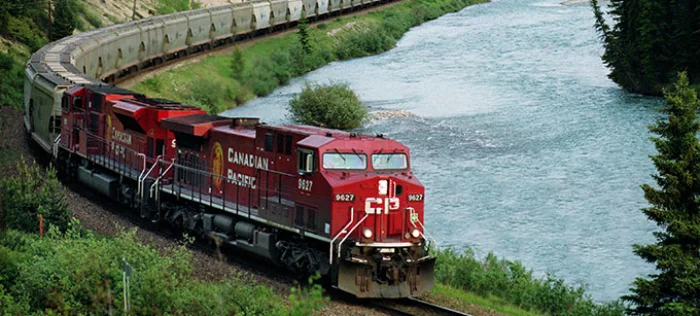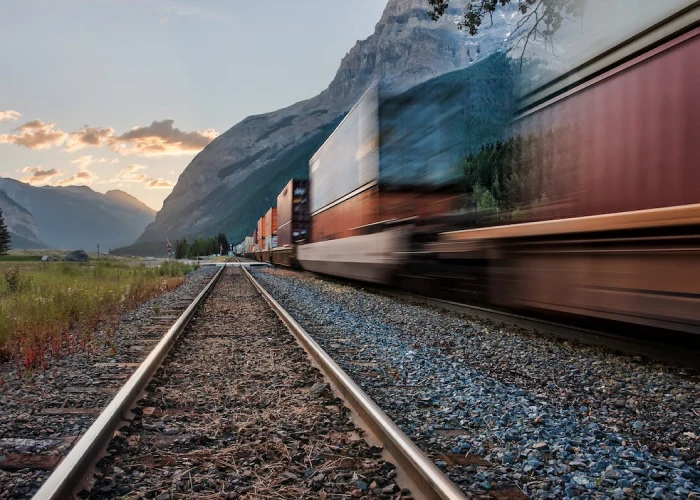American rail freight shipping has the largest and most envied freight rail network in the world. With approximately seven primary Class 1 railroads and 140,000 track route miles stretching from coast to coast. US freight railroads ship just about everything consumers and businesses depend on. From the food we eat to the cars we drive. Things we use every day have most likely been shipped by train.
Table of Contents
What Makes Canada Rail Freight Shipping Different?
From the West Coast to the East Coast, the United States has one of the safest, most extensive, and most reliable rail freight shipping systems in the world, thanks to the numerous rail freight companies operating across the country. These companies transport a wide range of goods, from agricultural products to building materials, household items, clothing, and shoes. The Canadian rail system also plays a vital role in this network, providing an efficient means to move freight across the United States.
When it comes to effectively shipping the goods families use daily, the supplies businesses need to grow. And the products that fuel our international trade, the US rail freight system is the best.
These factors have made Canada rail freight shipping network the best of the best:
- Property: Unlike most foreign railroads, American rail freight shipping, for the most part, involves privately owned rail shipping companies rather than being government-owned or operated. Being privately owned allows America’s freight railroads to raise billions of dollars in private capital to finance maintenance, reducing their reliance on taxpayer funding. This private ownership model is a distinctive feature of the American rail freight shipping industry, setting it apart from many other countries’ rail systems.
- Geography: The vast geography of the United States has only limited regional population density. That resembles areas served by foreign passenger rail networks. With more than 28,000 locomotives, 1.6 million rail cars, and freight rail lines stretching 140,000 miles. America’s freight rail system is perfectly positioned to be the most efficient transportation network. And a profitable network covering all 3.12 million square miles of the continental US for shipping freight by rail.
Related article: Make The Best Decisions For Your Shipments

Number 1 Railroads in Canadian rail freight shipping
Number 1 railroads, typically known for long-haul transportation of commodities with as few stops in between as possible, are among the major rail freight companies that own the majority of the track in North America. These railroads have lines stretching across the entire continent, reflecting their significant role in the rail freight industry.
The monetary figures that classify train classes change over time; however, the primary meaning of a Class 1 railroad remains the same: these are the largest railroads in terms of annual operating revenue and are headquartered in North America, representing key players in the rail freight sector.
Read more: North America Railroad System Benefits
Seven Class 1 railroads operate in 44 states, the District of Columbia, and parts of Canada and Mexico. Together, they account for 69 percent of all track mileage and employ 90 percent of US rail workers.
Union Pacific Railroad: Headquartered in Omaha, Nebraska
Founded in 1862, Union Pacific (UP) has provided rail transportation for 156 years. It is the largest railroad in North America, operating 51,683 miles in 23 states. The company employs 43,500 people and owns and leases 8,573 locomotives. And typically ships commodities such as coal, chemicals, food and forest products, automobiles, and agricultural products.
Related article: Is Dedicated Fleet Service Right For Your Company?
BNSF Railway: Headquartered in Fort Worth, Texas
Burlington Northern and Santa Fe Railway, better known as BNSF, is one of the prominent rail freight companies in the United States. Founded in 1849, it is now the second-largest American railroad company. Spanning 28 states and three Canadian provinces, BNSF operates an extensive network with 32,500 miles of track and 8,000 locomotives. This vast operation employs more than 41,000 people, highlighting its significant role in the rail freight industry. Products shipped most frequently by BNSF include grains, raw materials, electronics, apparel, and low-sulfur coal, demonstrating the diverse range of commodities transported by this major rail freight company.
CSX Transportation: Headquartered in Jacksonville, Florida
Since 1827, CSX Transportation has helped transport goods across the United States. The company operates a 21,000-mile system in 23 states. Like the District of Columbia, and the Canadian provinces of Ontario and Quebec. Its network reaches nearly two-thirds of the nation’s population. Which connects to more than 230 short-line and regional railroads. And more than 70 sea, river, and lake ports along the Atlantic and Gulf coasts, the Mississippi River, the Great Lakes the Saint Lawrence Seaway.
Canadian National Railway: Headquartered in Montreal, Quebec
Canadian National Railway (CN) began operations in 1918. It is the largest rail network in Canada and the only transcontinental network in North America. Its system encompasses 19,600 miles of track in 16 US states and eight Canadian provinces. It offers rail connections to three coasts. The company has more than 22,000 employees who help serve:
* [The automotive, coal, fertilizer, food and beverage, forest products, grain, and intermodal markets.]
Related article: What to Look for in a Full Truckload Provider
Norfolk Southern Railway: Headquartered in Norfolk, Virginia
Founded in 1838, Norfolk Southern (NS) is a major shipper of coal, automotive, and industrial products. It operates 19,500 miles of rail in 22 states and the District of Columbia owns and leases 4,155 locomotives and 62,705 freight cars, and employs more than 27,000 people. Norfolk also carries freight from all major East Coast ports between New York City and Jacksonville, Florida.
Canadian Pacific Railway: Headquartered in Calgary, Alberta
Canadian Pacific (CP) Railway began operations in 1881. Today, the company owns 15,000 miles of track in 13 states and six provinces. CP plays a critical role in rail transportation. Connecting ports on the Pacific and Atlantic coasts to major North American distribution centers and all Number 1 railroads. Major industries served include automotive, coal, energy, ethanol, food production, industrial products, and intermodal.
Kansas City Southern:
Based in Kansas City, Missouri, established in 1887, Kansas City Southern (KCS) is the smallest of the Class I railroads. Operating just 6,000 miles of track in the US and Mexico. KCS is made up of three railroads: the Kansas City Southern Railways Company, the Kansas City Southern de Mexico, and the Panama Canal Railway Company. Commonly shipped commodities are aggregates and minerals, agricultural products, household appliances, chemicals, consumer goods, food products, and plastics.
Related article: 10 Most Commonly Asked Freight Shipping Questions In Logistics – Canada

American Rail Freight Shipping Class 1
The North American rail transportation system has a high level of geography. It is specialized in large rail carriers serving significant regional markets. Canada rail freight shipping railroads own the majority of the track in North America. With lines stretching across the entire continent. The monetary figures that classify train classes change over time. However, the primary meaning of a Number 1 railroad remains the same, the largest railroads in terms of annual operating revenue are headquartered in North America. The Number 1 railroads we recognize today include Canadian Pacific, Canadian National, CSX Transportation, Norfolk Southern, Union Pacific, BNSF Railway, and Kansas City Southern.
Related article: What Is Expedited Shipping & Why Would I Need It
What types of cargo are best suited for American Rail Freight Shipping?
American Rail Freight is well-suited for transporting commodities in bulk, including raw materials, minerals, and heavy goods, owing to its efficient handling of large and heavy loads.
How does the environmental impact of rail freight differ from other transportation modes?
American Rail Freight Shipping is considered more environmentally friendly than some alternatives, as trains generally have lower emissions per ton-mile compared to trucks, contributing to sustainability goals.





